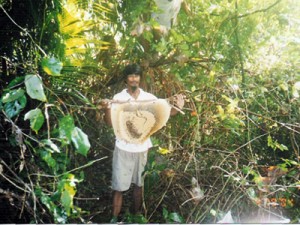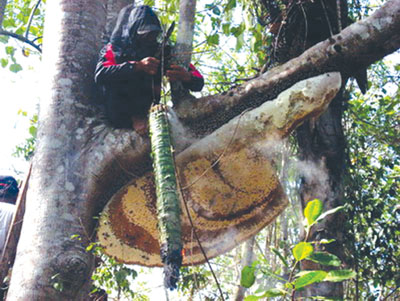by Thomas Irawan, Riak Bumi
The Periau is a traditional organisation of forest honey collectors in Sentarum Lake, West Kalimantan, Indonesia. The Association of Periaus of Danau Sentarum (APDS) is a peoples organisation of 89 forest honey collectors from five Periaus, i.e., Periau Suda, Meresak and Danau Luar from Nanga Leboyan village, Periau Semangit from Semangit village, and Periau Semalah from Semalah village.
The APDS manages an area of 7.300 hectares that produces about 4-10 tons of forest honey per year. This year, ten more Periaus will be joining the APDS. These are Periau Tempurau, Nanga Telatap, Pulau Majang, Lubuk Kelekati, Lubuk Pengail, Belibis Panjang, Pengembung, Nanga Sumpak, Pemerak and Lupak Mawang. Total APDS membership will extend to 275 forest honey collectors with a total Periau area of 28,000 hectares (25% of Danau Sentarum National Park Area) and a potential production of 12-25 tons.
On March 2007, APDS succeeded in applying for Internal Control System (ICS) and can assure 4.3 tons good quality honey. In May of the same year, BIOCert recognizes the organisation’s honey as organic, which they confirmed after they carried out an external inspection. About 4.3 tons of honey was sold to Dian Niaga and Riak Bumi through the cooperation of the Forest Honey Network at Rp 28.000/kg price at local sites.
Overcoming tensions and conflicts
It was only through hard work that the APDS was finally able to achieve this. The most difficult part was when the APDS applied for its first internal control inspection during the harvest season of February-March 2007.
There are cultural differences brought by ICS and they found the need to shift from an emotional relationship to a functional relationship amongst themselves. The culture brought by ICS is a culture of management control and personal responsibility. Members also realised that they must document all transactions and control events in written reports. There was a need for more openness, more discipline and firm sanctions. There were some tenions resulting from the clash of between verbal and written cultures; and between family fashioned and management control.
Success factors
It was interesting to see that the APDS leadership played a critical role in overcoming these differences and tensions. The differences are accepted and adapted to maintain social solidarity. Control is carried out firmly while maintaining harmonious relationships. While openness is encouraged, there is no intent to humiliate individuals. Finally, sanctions are not intended to punish but to remind and to improve broken social relationships.
 Also interesting was that the APDS and other parties in their communities found ICS useful for combining community business and community organising, and not just for certification. They are aware that certification alone could also hinder organising, especially when communities had applied ICS and standards well but could not be certified organic because of external factors. In that case, the product should be able to sell even without an organic label. Certification could be very useful in dealing outside, but it is not the primary concern.
Also interesting was that the APDS and other parties in their communities found ICS useful for combining community business and community organising, and not just for certification. They are aware that certification alone could also hinder organising, especially when communities had applied ICS and standards well but could not be certified organic because of external factors. In that case, the product should be able to sell even without an organic label. Certification could be very useful in dealing outside, but it is not the primary concern.
The APDS also realised that through ICS, they can organise themselves to build capacity, to synergize all potential resources and to increase bargaining position. Mulyadi, head of Semangit village, for instance, used the materials of ICS to organise fishermen in his sub-village. In the fishermen organisation, there is now more clarity of duty, responsibility, obligation and authority in every position in the organisation. Aziz Muslim, one of the APDS member candidates from Belibis Panjang village, applies these principles in a cooperative union that trades oil and smoked fish.
Why does the ICS work well in APDS? Maybe this is because of the inherent characteristic of Periau’s wisdom. The communities of Periaus generally consist of old forest honey collectors that have a long experience in harvesting forest honey. They are patient people, very diligent, rigorous and careful in working, intentional in speaking and dependable co-workers. They pay full attention to their environment especially when they are harvesting forest honey; they are not greedy to take from nature. The most important thing is that harmony is an integral part of their life and work. If they did not keep harmony in their work, instead of getting forest honey they would get forest honey bee stings!
Expansion
If we open our minds and push for the APDS to grow and gain greater influence in Danau Sentarum National Park, the nature of natural resources management in the national park could be changed; it would be ICS adapted by Periau wisdom.
It is very possible that this opportunity was seen by the Head of Sentarum Lake National Park Agency which urged him to promote the APDS to receive BIOCert Certification through the Minister of Forestry. The certification by BIOCert gains greater clout as it is also acknowledged by the Sentarum Lake National Park Agency and the Forestry Department. Everyone seems to have great expectations for this APDS, and success can be realised through the spirit of solidarity, participation and transparency, and community empowerment.
Email: thomasirawansihombing AT yahoo.com





